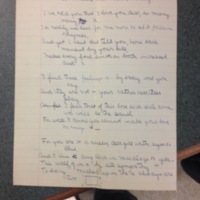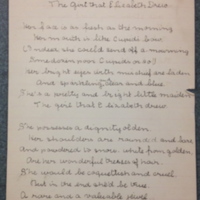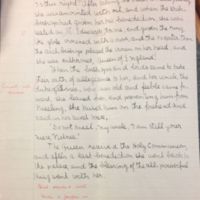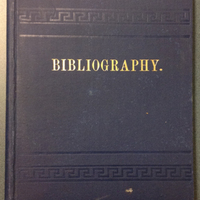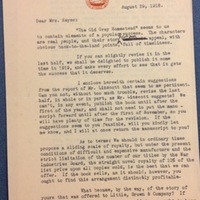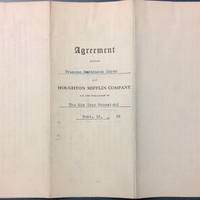Becoming Frances : Writing Out of the Attic
Keyes dates the beginning of her writing career to when, at age seven, she and a friend wrote a pageant that they performed for Frances’s mother Louise. According to Keyes, when she was young her mother encouraged her writing, treasured a story she wrote called The Rebel Captain’s Sweetheart, and sent Frances’s patriotic verses to a local newspaper. [1] When they were in Europe in 1895, her mother transcribed a short piece Frances wrote about travels in the Netherlands and sent it to St. Nicholas Magazine. Throughout the 1890s, Frances’s correspondence with her mother often included stories, fairy tales, or references to writings Frances was working on. Keyes’s UVM collection also has additional stories written in 1902.
As Frances continued to write, she found her mother less receptive and even dismissive of her work. In Roses in December, Keyes recounts how Louise, after discovering that Frances had sent some of her verses to the Boston Transcript, shredded them “into tiny bits” and threatened to remove her from Miss Winsor’s School. Her mother’s actions “tore something in my heart,” Frances wrote. “I never again showed her my verse. Indeed, I never again showed her anything I had written, until it had first been approved by some authority which she would recognize. And even then I did so seldom and warily.” [2]
After becoming a published writer, Keyes expanded the circle of those who discouraged her writing efforts. In 1920, one reporter wrote: “Nobody believed she could write and nobody wanted her to write.” [3] Included in this group of “nobody” was her husband Harry who, she stated, “regarded my predilection for scribbling with an eye as unfriendly and disparaging as my mother’s.” Fearing his disapproval, Keyes retreated to the attic of their house and, when she finished with her writing, hid her papers in her underwear drawer. She was living, she later said, a “life of deception.” [4]
Deception or not, by November 1917 Keyes was a public writer. Her first article, “The Pride and Form of Mourning,” which endorsed the idea that women who had lost loved ones in the war should wear a gold star as a symbol of their sacrifice, was published in The Chronicle, a New York magazine funded by a group of wealthy women (including the antisuffragist Alice Hay Wadsworth). [5] Next came the publication of her sketch of her grandmother Frances Parkinson in the Granite Monthly, a New Hampshire magazine that went on to publish more of Keyes’s historical sketches and a few of her stories as serials.
What motivated and allowed Keyes to write? Keyes gives many answers to this question in Roses in December, including the encouragement of her grandmother, the confidence instilled in her by friends such as Elizabeth Sweetser, and her reading of a broad range of texts from the Bible to Goethe to Dickens to Margaret Sidney and beyond. [Some of these readings are recorded in Keyes’s “Bibliography Journal” for 1902 and 1903. Others she mentions in her writings.]
There were also, after her marriage, practical reasons for writing. The Keyes family did not have “any solid financial foundation” and Frances’s attempts to economize only went so far in helping to pay incoming bills. When the family’s credit was not accepted at the Boston store, where Frances attempted to buy a dress to wear at her husband’s inauguration, Keyes declared that “somehow, as soon as possible, I must find a way of paying for my own clothes.” [6] The strain of family finances made checks from publishers and editors an important incentive for working on another piece of writing.
Another reason for writing can be found Keyes’s reaction to the acceptance of her first novel, The Old Gray Homestead. She wrote that a “second great change had taken place in my life. The first had occurred when I became a bride and merged my being with my husband’s. Now this union still existed, and I had, besides, a destiny of my very own.” [7] Marriage and motherhood were central parts of Keyes’s life after 1904 but they were not her whole life. Writing was her personal destiny.
There is one more (but certainly not the last) reason to explore when dealing with the subject of Keyes’s early development as a writer. It concerns her Aunt Nancy.
Notes:
1) Roses, 169. ↵
2) Roses, 169-172.↵
3) Maud McDougall, “Woman Who Couldn’t Hide Under a Basket,” Oregonian, August 29, 1920. ↵
4) All Flags Flying, 53, 135, 140. ↵
5) McDougall, “Woman Who Couldn’t Hide”; All Flags Flying, 99. ↵
6) All Flags Flying, 75-76, 88-89.) ↵
7) All Flags Flying, 103. ↵
Related Documents:

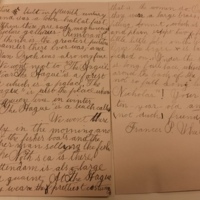
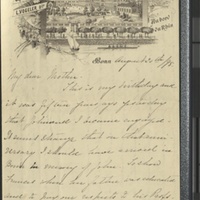
![FPK to Mother [189?] FPK to Mother [189?]](http://libraryexhibits.uvm.edu/omeka/files/square_thumbnails/f07268ad7e0330403f1b1ee7055f13d4.jpg)
![The Girl That Was Not Pretty [189?] The Girl That Was Not Pretty [189?]](http://libraryexhibits.uvm.edu/omeka/files/square_thumbnails/099a3a6694de309b41cf471b85c959c3.jpg)
